We all know how to make our beds, but are we doing it correctly?
How many of you can name the three steps that go into the creation of hospital corners? What’s the point of calling them that? That will be addressed. Making a bed, on the other hand, isn’t rocket science, but there are a few key measures to remember if you want to sleep well and comfortably.
This how-to on making your bed will come in handy if your sheets are always tangled around your feet when you wake up in the morning. Sheets twisted together are a pain!
Layers of a Bed
Base Layers
Additional layers can be added if desired:
- To conceal the box spring and keep the space under the bed from being visible, use a dust ruffle. A bed skirt is another name for it. There are both ruffled and smoothed-out varieties, which is why the term was chosen.
- Despite the fact that a mattress pad is technically optional, we see it as an essential piece of bedding. The primary function of these comfort layers is to protect the mattress’s fabric, not to soften it. Almost anything can make its way onto your mattress through your bed sheets. Moving or donating your mattress will reveal unpleasant stains from perspiration and other bodily fluids. Protecting the surface with a pad or mattress cover will keep it looking new.
Bottom Sheet
Elastic is sometimes used to fasten the bottom sheet to the mattress, either along the edges or all the way around. It’s common for individuals to despise folding fitted sheets, but they’re essential for keeping your bed clean and pleasant.
Top Sheet
The top sheet is the following layer. Unless you purchase each piece separately, the color and pattern of the fitted sheet is likely to be the same as the rest of the bedding.
Blanket
Depending on the season and your own preferences, you may or may not choose to use a blanket. You can either fold the blanket and store it at the foot of the bed or insert it between the top sheet and the top layer. What do you think?
Top Layer
A comforter, duvet, or quilt serves as the topmost covering. Because duvet covers are easier to care for, they’re becoming more popular. A duvet cover can be washed in the washing machine and then used to cover a quilt, but a comforter or heavy quilt would require professional cleaning.
Pillows
The odd-number rule is recommended by interior designers. As a result, you’ll need to make your bed with three to seven pillows. When you’re not using your pillows, keep them in a clean, dry place (not on the floor) so they don’t get soiled. Both a basket on the nightstand or a trunk under the bed are perfect.
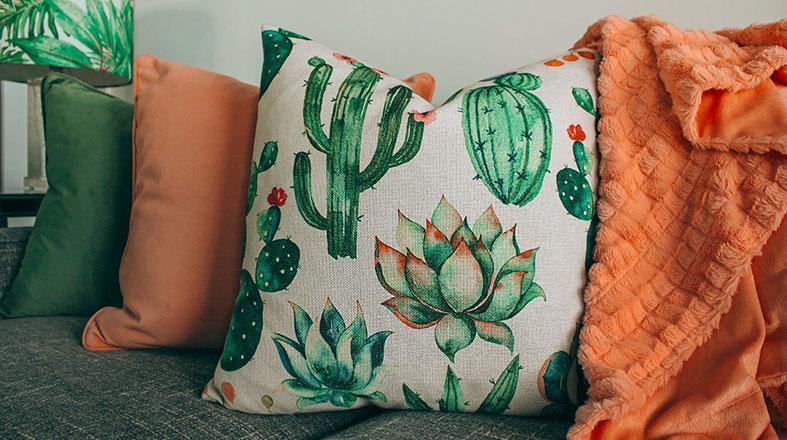
How to Make Your Own Bed
1. Start With a Bed Skirt
If you have an unattractive bed frame or storage boxes under your mattress, a bed skirt might help hide them. Just be sure to iron your bed skirt before using it to avoid creases. Here’s how to put your bed skirt on properly.
How to Put on a Bed Skirt
- Remove your mattress from your bed frame.
- For a full-length skirt, put it over your box spring, aligned with your frame.
- If you have a three-sided elastic bed skirt, line up the skirtless side of your headboard with the skirt.
- Make sure the stitches of your bed skirt are perfectly aligned with the frame of your bed.
- Your mattress should be positioned over the bed’s skirt.
2. Add the Mattress Topper
A mattress topper is a cost-effective solution to transform your bed into a slumbering sanctuary. You may modify your present mattress by adding a few additional inches of comfort to produce a soft and buoyant feel, keeping you cool and snug throughout the night. Just make sure you get a mattress topper with a viscoelastic bottom so that it doesn’t move about as you sleep. ‘
How to Add a Mattress Topper to Your Bed
- Use non-slip pads on the top of your mattress to help keep your mattress topper in place if it doesn’t have a viscoelastic bottom.
- Make sure your mattress topper is aligned with your mattress’ four corners before rolling it out on top of it.
- Continually add your bedding as normal.
3. Use a Mattress Protector
Unlike decorative pillows and blankets, a mattress protector is a necessity if you want to keep your bed clean for the long term. The feel and comfort of your sleeping surface won’t be harmed by using a quality mattress protector. The following are some additional advantages of using a mattress protector:
- Protects your mattress from stains and messes.
- Prevents stains from blood.
- The mattress protector makes it easy to remove pee from the mattress.
- Protects against the usual wear and tear of everyday life.
- Prevents dust, mites, and other microorganisms from making their way into your bed’s mattress.
How to Add a Mattress Protector to Your Bed
- Begin at the top corner and work down, starting with the uppermost corner of your mattress (and mattress topper if necessary).
- Make sure to tuck in each of the four corners before moving on.
- The rest of your bed linens should be put on in the same manner as usual.
4. Put on the Fitted Sheet
Fitted sheets are the foundation of your bedding and cover your mattress. Make sure you obtain the correct sheet sizes for your bed because fitted sheets are usually sewed with elastic edges that assist keep everything in place.
How to Put on a Fitted Sheet
- Fitted sheets should be placed on top of your mattress in the same lengthwise arrangement as the mattress itself.
- To begin, begin by pulling a corner of a fitted sheet over the side of your mattress.
- Make sure that the corner seam of your fitted sheet is aligned with the mattress’s top.
- Each of the four corners should be checked to see whether it fell out of place while the next was attached.
5. Put on a Flat Sheet
This layer of protection prevents body oils and grime from being transferred to the top layer of your comforter or duvet by using flat sheets. There is a lot of disagreement about whether or not flat sheets are necessary, with roughly six out of 10 Americans saying they are.
The appropriate material can make all the difference, whether you’re a fan of flat sheets or not. To ensure a restful night’s sleep, choose the correct bedding: whether it’s percale sheets or sateen sheets.
How to Use a Flat Sheet
- Using the same orientation as your other bedding, spread a flat sheet across the length of your bed.
- Make sure there is enough of the flat sheet to tuck under on the sides and end of the bed before putting it on your bed.
- The top edge of your top sheet should line up with the top of your mattress, so make sure to double-check this.
- Underneath your blankets, tuck the bottom of your top sheet.
- Use the sides of a flat sheet to make hospital corners (see instructions below).
How to Do Hospital Corners
Flat sheet folds, such as hospital corners, give your sheets a clean, crisp appearance. How to fold them neatly is here.
- When you’re done folding the end of the top sheet under the end of your mattress, you should leave the sides hanging out.
- Remove the top sheet and place it about one to two feet from the bed’s edge for easy access. At a 45-degree angle from the mattress’ corner, lift this component up.
- This piece should form a triangular shape at the foot of your bed when placed on top of your mattress. Tie off any loose ends with this piece and tuck the extra sheet under your bed. Ensure that the surplus sheet is properly tucked in rather than jammed underneath for the greatest results.
- Afterwards, fold the triangle-shaped part down and tuck any edges that hang below your mattress.
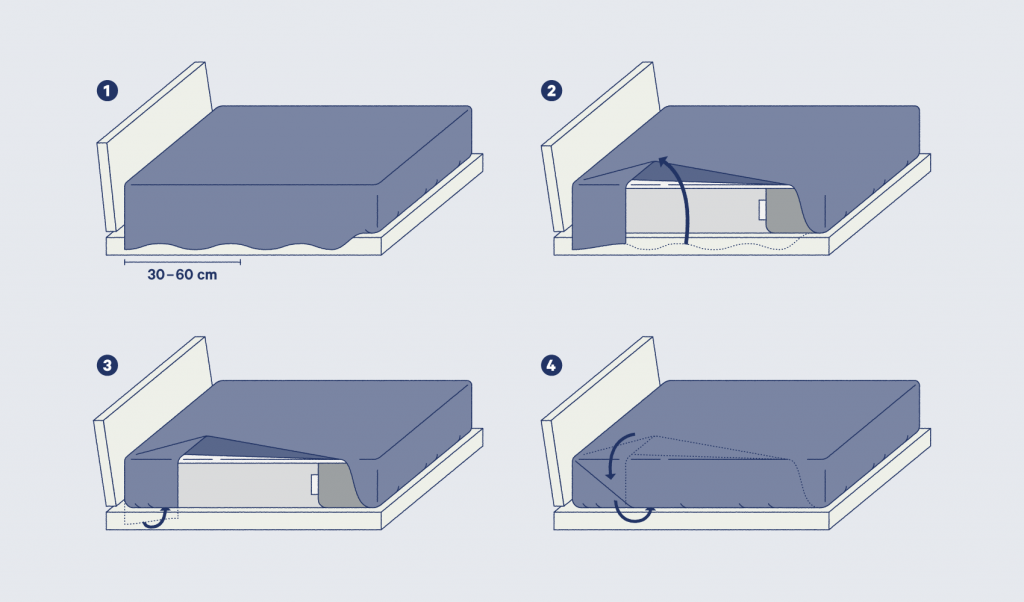
6. Place the Comforter or Duvet
The phrase “comforter” and “duvet” are often used interchangeably, however these two sleeping layers are very distinct. A duvet, like a pillow and pillowcases, is made up of an insert and a cover, but a comforter is a single quilted piece of bedding that sits on top of your sheets.
Putting on a duvet cover can be more difficult than washing a duvet, because you have to chuck it in the washer with the rest of the clothing. However, because most people use a flat sheet instead of a duvet, comforters don’t need to be washed as frequently as those that do require special care.
How to Put on a Duvet or Comforter
- On top of your bedding, use a duvet or comforter that is aligned with your bed.
- Take a close look at your duvet cover and make sure it covers the entire bed evenly.
- Fold the borders of your duvet or blanket under your bed if you prefer tighter sheets. Leave it as is if you like a more relaxed appearance.
- The pattern on the inside of your sheets can be seen by folding the top sheet and duvet together in your hands.
7. Add Pillows
Bedding embellishment can begin as soon as your linens are in order. When deciding how to make a bed, the size and type of pillows you use might make a difference.
Memory foam is an excellent option for a base pillow, whereas down pillows are ideal for focal pillows because of their lightness and loftiness. To complete the aesthetic of your bed, whether it’s two regular pillows or a pair of Euro pillows that you want, designing your pillows is an essential part of the process.
How to Arrange Pillows on a Bed
- Grab both sides of your pillows and squeeze them together to fluff them up.
- Pillows should be placed near the head of your bed, between the duvet and the headboard or wall, in order to maximize the space. It is possible to arrange these pillows numerous ways, including stacking them on top of each other, adding throw pillows or using European shams as an additional layer of comfort.
- In order to give the appearance of being lived in, “karate chop” your pillows once they’ve been put in place.
- Throw pillows can be placed in front of your regular pillows.
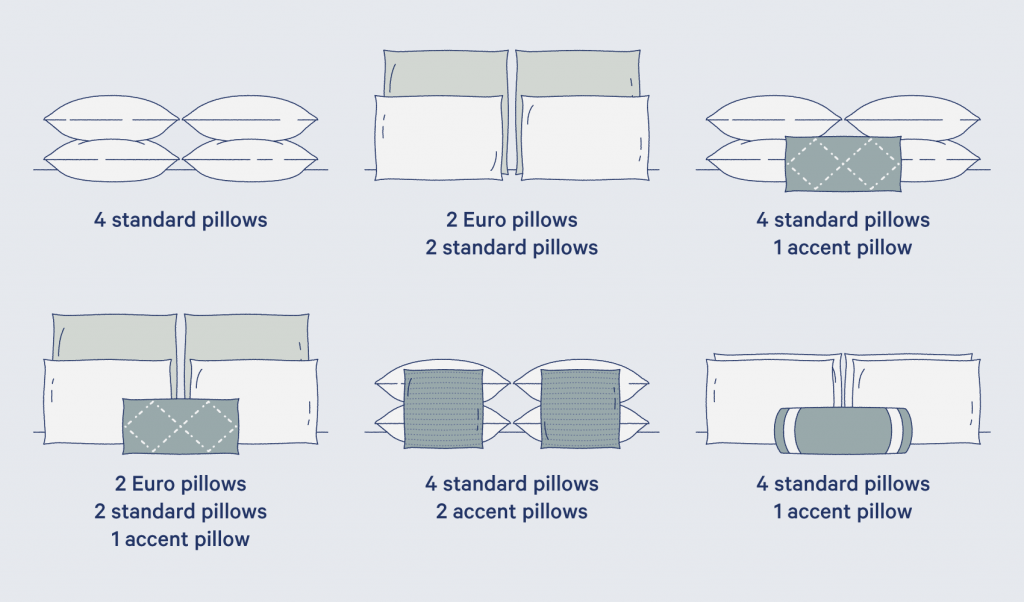
8. Finish With Throw Blankets on Your Bed
In the morning, what do you do with the throw blankets you use at night? Styling your throw blankets on your bed in a way that is both fashionable and effortless can make them part of your room’s dcor. With a weighted blanket or a soft, cuddly fleece blanket, you may give your bed a finished look that’s both comfortable and stylish.
How to Put a Throw Blanket on a Bed
- It’s time to get creative with your throw blanket by folding it in half (or scrunch it up for that organic lived-in look).
- The length of the blanket should span the breadth of your bed, so style it at the foot of your bed.
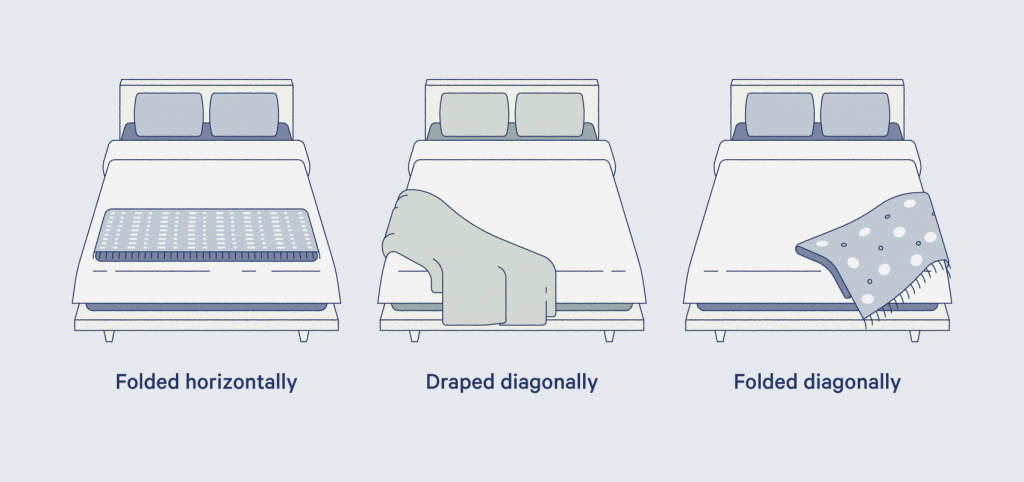
Making your bed every day will help you feel more energized when you get up in the morning. A good night’s sleep begins with making your bed. Whether you diligently tuck your hospital corners or you simply want your duvet to appear clean at the end of the day, making your bed is the first step.
Is it time to go to sleep? Consider a new set of comfy bedding to improve your night’s rest.
Healthy Bed Habits
Fix Your Bed Every Morning
Making your bed every morning has recently become the subject of a flurry of research. It elevates your mood and offers you a sense of accomplishment as well as enjoyment. Every day, the majority of us are confronted with a variety of difficult and time-consuming chores. You’ll be able to cross things off your to-do list and maybe keep that momentum throughout the day if you manage to make a good bed.
Wash Your Beddings every 1 to 2 Weeks
To keep your sheets clean, you don’t need to wash them every day or even every week. You can get away with washing them once every two weeks if they don’t smell. Duvet covers and other items that don’t come into direct contact with your skin can be washed once a quarter.
Simplify Duvet Layering
The ideal approach to cover a duvet is described in the procedure provided above. In our opinion, a cover is considerably more convenient than needing to find industrial-sized washers or professional (and expensive) dry cleaners to keep your bedding looking new. If you’re still having trouble putting the cover on your duvet, ask a friend to help you get it done quicker.
Use a Mattress Pad
Underneath the fitted sheet, the mattress pad is placed directly on top of the mattress. Look for a mattress cover with cooling or support features if you have a tendency to overheat while sleeping or if your mattress is no longer comfy. When it comes to protecting your mattress from stains, bodily fluids, and spills, we recommend a simple cotton pad. To make matters worst, when you go to change your linens, you have to look at a stained mattress.
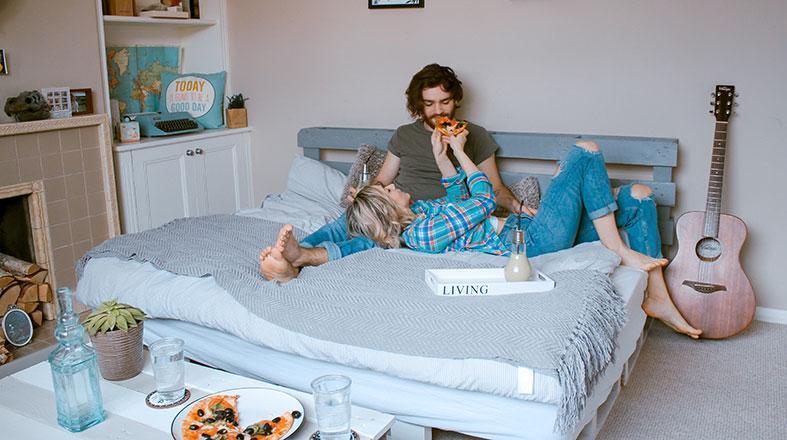
Frequently Asked Questions
How should I make a hotel-style bed?
The first step in recreating the look and feel of a hotel room is to choose crisp white cotton bedding. For the top page, we suggest using hospital corners as well. As soon as you have folded the duvet in thirds, the white sheet will stand out. Pillows complete the look. Add two to four normal pillows, two Euro pillows, and a tiny accent pillow, following the rule of odd numbers.
How should I make a bed with a footboard?
This is a straightforward technique, but you’ll have to work around the footboard. Lifting your mattress may be necessary if your arms and hands are too wide to fit in the gap.
What can I add to make it comfier?
Our first suggestion for making it more comfortable is to use a practical mattress pad. With the addition of pillows and soft blankets, the sanctuary-like sensation can be recreated.
How can I layer a bed with a quilt?
Yes, without a doubt! Your imagination is the only limit here. Additional blankets are useful in cold temperatures. Fold it in thirds and place it at the foot of the bed if you’d rather use it as an accent piece.
What are the benefits of making your bed every day?
A good approach to start the day is by making your bed. Achieving a goal in the beginning of the day gives you a sense of accomplishment that you may carry throughout the day. In the end, there is nothing like a well-made bed to make you feel like you’re cocooned in a warm blanket.
Conclusion
In light of how much time we spend sleeping, we believe that a well-made bed merits a bit more attention. How many times have you struggled to get into bed because your sheets were twisted or your pillows were all over the place? As an alternative, wouldn’t it be nice to snuggle up in a pristine, cold and tightly tucked duvet cover? It may help you get a good night’s sleep. Tell us if that happens!

![Top Rated CPAP Machine Buyer’s Guide [current_date format=’m/Y’]](https://bestpillowsleepers.com/wp-content/uploads/2023/03/best-cpap-machine-img_6405d72310053-400x300.jpg)
![The 11 Best Cooling Weighted Blankets [current_date format=’m/Y’]](https://bestpillowsleepers.com/wp-content/uploads/2023/01/best-cooling-weighted-blankets-img_63d4ff15c615d-400x300.jpg)
![Ultimate Guide to Choosing a Best Cooling Mattress Pads [current_date format=’m/Y’]](https://bestpillowsleepers.com/wp-content/uploads/2023/01/best-cooling-mattress-pads-img_63c403115126b-400x300.jpg)
![Ultimate Guide to Choosing a Best Cooling Mattress [current_date format=’m/Y’]](https://bestpillowsleepers.com/wp-content/uploads/2023/01/ultimate-guide-to-choosing-a-best-cooling-mattress-img_63bcdba870d77-400x300.jpg)
![Ultimate Guide to Choosing a Best Cooling Comforters [current_date format=’m/Y’]](https://bestpillowsleepers.com/wp-content/uploads/2023/01/ultimate-guide-to-choosing-a-best-cooling-comforters-img_63bba2f5cd3ce-400x300.jpg)